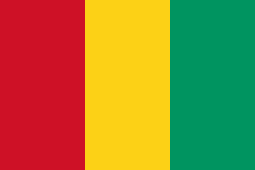Flag of Guinea
The national flag of Guinea (French: drapeau de la Guinée) was adopted on 10 November 1958.
 | |
| Use | National flag and ensign |
|---|---|
| Proportion | 2:3 |
| Adopted | 10 November 1958 |
| Design | A vertical tricolour of red, yellow and green |
Design
The colors of the flag were adapted from those of the Rassemblement Démocratique Africain, the dominant movement at the time of independence. The colors were in turn derived from those of the flag of Ghana, which had first adopted them in 1957. Sékou Touré, the first President of Guinea, was a close associate of Kwame Nkrumah, the former president of Ghana.
Colors
Red symbolizes the blood of the martyrs who died from slavery and wars, yellow represents the sun and the riches of the country, and green the country's vegetation. In keeping with other flags in the region, the Pan-African movement's colors of red, yellow, and green are used.
The design is a tricolor. The colors of the flag from left to right are the reverse of the flag of Mali. The previous flag of Rwanda, whose design was inspired by the flag of the Kingdom of Rwanda, had a large black R to make it distinguishable from the near-identical flag of Guinea.